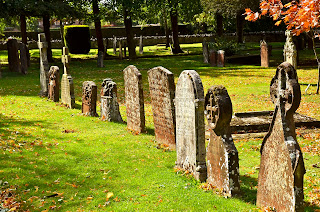Where do we go to find art? In Scotland, the Scottish National Gallery in Edinburgh has a wonderful display of paintings and sculptures. Anne and I find natural art on almost every golf course we visit--trees, flowers, the art of design. Cemeteries, church or kirk graveyards, bone factories seem to be one of the least likely spots to go chasing art, but there is much that is artistic in the graveyards, especially in Scotland. I’ve already shown examples in the last entry of one artsy aspect of the graveyards: the patterns of stones and light. The next aspect to examine is the art on the stones themselves, the carvings. The weathered stone carvings catch attention as we wander among the graves, but the meaning behind the symbols gives substance to the stone mason’s art.
The first category of carvings to explore are the Emblems of Mortality (Willsher, p. 38). Here is where I’ll go back to my misconceptions about the skull and crossbones. Instead of symbols referring to death by plague, the gruesome image simply says that this person is dead, as we all shall be. It is one of the symbols of mortality; symbols which remind us that death is a natural part of life which will come to us all as it has with this soul. Skull and crossbones is not the only image to remind us of our mortality, we’ve seen several others in the kirkyards of Scotland and England. Here are some examples of the carvings categorized as emblems of mortality:
Grave Digger’s Tools, such as the spade and turf-cutter (Muthill Old Church and Tower graves, Perthshire);
the Deid Bell rung to give notice of funerals seen in these twin grave slabs at the ruined St Peter’s Kirk near Duffus, Morayshire;
Winged Skulls are usually found on tombs from the 17th century, but this elaborate winged skull (University Church of St Mary the Virgin, Oxford, England) is obviously much later;
the Skeleton, the ultimate image of the death that comes to us all, like the one Anne sat next to in the Elgin Cathedral;
the Hourglass which indicates time is passing or, as seen in this grave slab in St Magnus Cathedral, Kirkwall, Orkney, has past;
Weapons of Death, such as the dart or arrow (St Magnus Cathedral);
and the Coffin as our final resting place (Elgin Cathedral, Elgin, Morayshire). This slab like many others displays multiple symbols of mortality; in this example, skull and crossbones, grave-digger tools, deid bell, hour glass, and the coffin.
A second category of carvings on the stones refer to Emblems of Immortality (Willsher, p. 42). These images seem to be less prevalent than mortality images, as if the living were more concerned with the inevitability of their own death rather than life forever after for the departed. One image of immortality that is quite easy to find is the Winged Soul or Cherub, as opposed to the less common winged skull. The first example is from Muthill Old Church and the second more elaborate carving is from Balfron Village Church, Scotland.
The other symbol often found is the Scallop Shell, a common object carried by pilgrims, which could also just be pretty decoration. At the Burford Parish Church, England, we found this unusual combination of mortality symbol (the skull) and the immortality symbol (the scallop shell).
It is more common to see the kind of scallop shell decoration we saw in the Dull Churchyard.
Other symbols of immortality that we’ve found include:
The Angus Dei, or figure of a lamb bearing a cross or flag which is said to represent the Passion of Christ, and the Phoenix, the mythical bird which rises out of its own ashes, which is a strong image of rebirth (both seen in the churchyard of the St Columba’s Episcopal Church in Crieff, Perthshire).
The Dove which is the symbol of the Holy Spirit was very popular in the 19th century. It is unusual, though, to find a carving of a dove on a memorial (Kinfauns graveyard near Perth).
The Wheel-head or Celtic Cross representing the eternal circle of life is both the symbol of hope and very artistic. This nice example is in the graveyard at St Peter’s Church in Haysham, England, near Lancaster.
The third category of carvings to discuss in this entry are carvings of symbolic scenes, especially Biblical scenes. Betty Willsher in Understanding Scottish Graveyards (2006) mentions three specific scenes to look for--Adam and Eve, Abraham and Isaac, and the Sower and the Reaper. In all the graveyards we searched on this trip (and looking at photos from past trips) I could find only two Adam and Eve stones, one at the Church of the Holy Rude cemetery in Stirling and the other at St Madeos Church near Perth.
Other examples of this story and other scenes will have to wait for future trips.
There is one more category of grave stone carving to explore, but that will have to wait for the next entry.




































